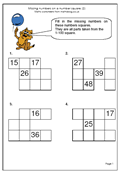 This is our second in a series for year 2 children where they have to complete the missing numbers in a 100 square. Some of the squares have been removed from the rectangles which, curiously, seems to make this task harder than when working with a complete rectangle. This is good practice for children who are not confident with counting up to 100. Don’t be surprised if children stumble over counting up to 100 out loud. It is something we often take for granted, but of course, has to be learned.
This is our second in a series for year 2 children where they have to complete the missing numbers in a 100 square. Some of the squares have been removed from the rectangles which, curiously, seems to make this task harder than when working with a complete rectangle. This is good practice for children who are not confident with counting up to 100. Don’t be surprised if children stumble over counting up to 100 out loud. It is something we often take for granted, but of course, has to be learned.
Category: Free Year 2 Maths Worksheets
Mental arithmetic: Know by Heart Pairs that Make 20
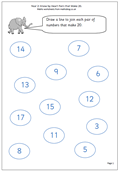 This maths worksheet for year 2 children looks at pairs of numbers which make 20. Before doing this children should be confident with, and know by heart, all pairs of numbers which make 10. Once they know these, pairs that make 20 becomes easy; just one of each pair is ten more e.g. 6 and 4: 16 and 4. Being able to work quickly with mental arithmetic is one of the keys to success in school as so much of the maths lesson today is carried out orally and children gain or lose confidence very quickly when answering in front of a whole class.
This maths worksheet for year 2 children looks at pairs of numbers which make 20. Before doing this children should be confident with, and know by heart, all pairs of numbers which make 10. Once they know these, pairs that make 20 becomes easy; just one of each pair is ten more e.g. 6 and 4: 16 and 4. Being able to work quickly with mental arithmetic is one of the keys to success in school as so much of the maths lesson today is carried out orally and children gain or lose confidence very quickly when answering in front of a whole class.
Maths Worksheet: Subtract a Single Digit (year 2)
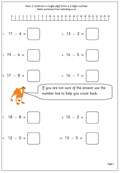 Once children are confident with subtracting single digits from single digits they can move on to subtracting from 2-digit numbers. This maths worksheet has a number line to help. Children can either start with the larger number and count back, or start with the smaller number and count on.
Once children are confident with subtracting single digits from single digits they can move on to subtracting from 2-digit numbers. This maths worksheet has a number line to help. Children can either start with the larger number and count back, or start with the smaller number and count on.
The next stage would be to start with the smaller number and know how many it takes to reach ten and then add on from there. E.g. 13 – 8. Start at 8 and know that add 2 will make ten. Continue from ten and add on the unit digit, in this case 3, to make 2 + 3 = 5. 13 – 8 = 5. A combination of knowing and counting on may well take place: many adults use this technique.
Mistakes can make me feel better!
 With well over 500 pages and a number of games I’m sure that mathsblog has made some errors that nobody has yet spotted. If you find anything please contact me and I will do my best to correct it as soon as possible. Meanwhile, I quite enjoyed seeing this little mistake in a published book on counting – it just goes to prove that we all slip on banana skins sometimes!
With well over 500 pages and a number of games I’m sure that mathsblog has made some errors that nobody has yet spotted. If you find anything please contact me and I will do my best to correct it as soon as possible. Meanwhile, I quite enjoyed seeing this little mistake in a published book on counting – it just goes to prove that we all slip on banana skins sometimes!
Thanks to failblog for this contribution (not suitable for children).
Year 2 maths worksheet: finding halves (pg 2)
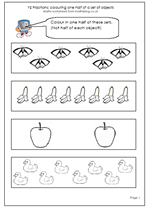 The third in our mini series of fraction maths worksheets. This looks again at halves and finding half of a set of objects, keeping to small, even numbers. The best way to re-inforce this work is to carry out practical activities, dividing groups of objects into two equal groups – make sure you keep to an even starting number. Sweets, marbles, lego bricks etc are ideal for this.
The third in our mini series of fraction maths worksheets. This looks again at halves and finding half of a set of objects, keeping to small, even numbers. The best way to re-inforce this work is to carry out practical activities, dividing groups of objects into two equal groups – make sure you keep to an even starting number. Sweets, marbles, lego bricks etc are ideal for this.
Year 2 maths worksheet: fractions, halves
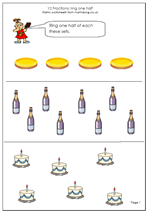 This is the second in our mini-series of fractions worksheets suitable for year 2 children, aged 5/6. The first looked at taking half of an object, in other words dividing one thing into two equal parts. This worksheet looks at a different idea of a half, that is, taking half of a number of objects. Children of this age should be beginning to know, off by heart, their doubles and halves of small numbers, and this type of work will help them.
This is the second in our mini-series of fractions worksheets suitable for year 2 children, aged 5/6. The first looked at taking half of an object, in other words dividing one thing into two equal parts. This worksheet looks at a different idea of a half, that is, taking half of a number of objects. Children of this age should be beginning to know, off by heart, their doubles and halves of small numbers, and this type of work will help them.
One way to do this is to pair off the objects, one at a time. Maybe make a small mark on them, although practical work is still the best way to do this. Another way is to count all the objects and then work out what half would be. With a small number of objects it is much easier to see instantly what half is. Again, it is important to show that there is more than one to show the answer. A good mini investigation would be to show the same 6 buttons several times and ask for different ways to ring half of them.
Y2 Maths worksheet: Fractions, recognising halves
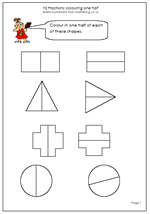 An important part of early fractions work is to recognise that usually there is more than one way to colour/shade/take one half of a shape. This maths worksheet, written for year 2 children, helps with recognising halves and also demonstrates with each of the four shapes that there is more than one way to divide them into two equal parts. A similar exercise can be carried out when asking children to take half of a number of objects (buttons etc). This will follow late on another worksheet.
An important part of early fractions work is to recognise that usually there is more than one way to colour/shade/take one half of a shape. This maths worksheet, written for year 2 children, helps with recognising halves and also demonstrates with each of the four shapes that there is more than one way to divide them into two equal parts. A similar exercise can be carried out when asking children to take half of a number of objects (buttons etc). This will follow late on another worksheet.
Times Table practice: 2, 3, 5 and 10 times tables
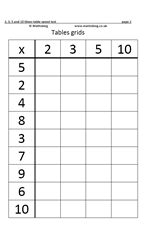 This is the second in a continuing series of times table practice for the 2, 3, 5 and 10 times tables.
This is the second in a continuing series of times table practice for the 2, 3, 5 and 10 times tables.
Any child who knows their tables off by heart is at a huge advantage over those who don’t know them. Many maths problems and techniques, such as long multiplication and division, rely on knowing tables, so it is really worth the effort to learn them. Watch how the grid is filled in as it gives good clues as to what has been learned (which takes no time at all to answer) and what has been ‘worked out’ (which might take a while). Say the table out loud many times – there are songs and recordings that will help.
Year 2 maths worksheet: missing numbers on a number square
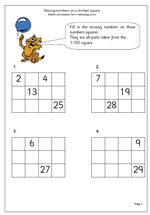 A 100 number square is an essential item to help young children with their maths. This worksheet takes parts of the number squares and asks for the missing numbers to be filled in. It is interesting to watch how children do this kind of activity as it involves both counting on and counting back and a realisation that the number immediately below is always ten more. Most children will prefer to work from left to right, counting up, but they should be encouraged to also work from right to left, counting back, and vertically, pointing out that the units remain the same, but the tens increase by one ten for each square below.
A 100 number square is an essential item to help young children with their maths. This worksheet takes parts of the number squares and asks for the missing numbers to be filled in. It is interesting to watch how children do this kind of activity as it involves both counting on and counting back and a realisation that the number immediately below is always ten more. Most children will prefer to work from left to right, counting up, but they should be encouraged to also work from right to left, counting back, and vertically, pointing out that the units remain the same, but the tens increase by one ten for each square below.
Year 2 maths worksheet:Understanding division as sharing
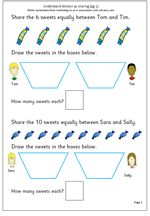 Division is usually the hardest of the four rules for children to learn, but in the early stages it is quite straightforward. Children often come across division for the first time when sharing, usually between two. The key concept,of course, is that the sharing is done equally. So, for example, 6 sweets shared between 2 children implies that the sharing is equal and they both receive the same number.
Division is usually the hardest of the four rules for children to learn, but in the early stages it is quite straightforward. Children often come across division for the first time when sharing, usually between two. The key concept,of course, is that the sharing is done equally. So, for example, 6 sweets shared between 2 children implies that the sharing is equal and they both receive the same number.
By far the best way to practice sharing is to use practical apparatus or use real life situations. Eg share the strawberries equally between two, share or deal the cards equally etc. Usually this is done on a ‘one for you and one for me’ type process until there are none left. This maths worksheet replicates a practical situation, with the ultimate aim that children begin to remember the answers, which, of course are the inverse of multiplication.